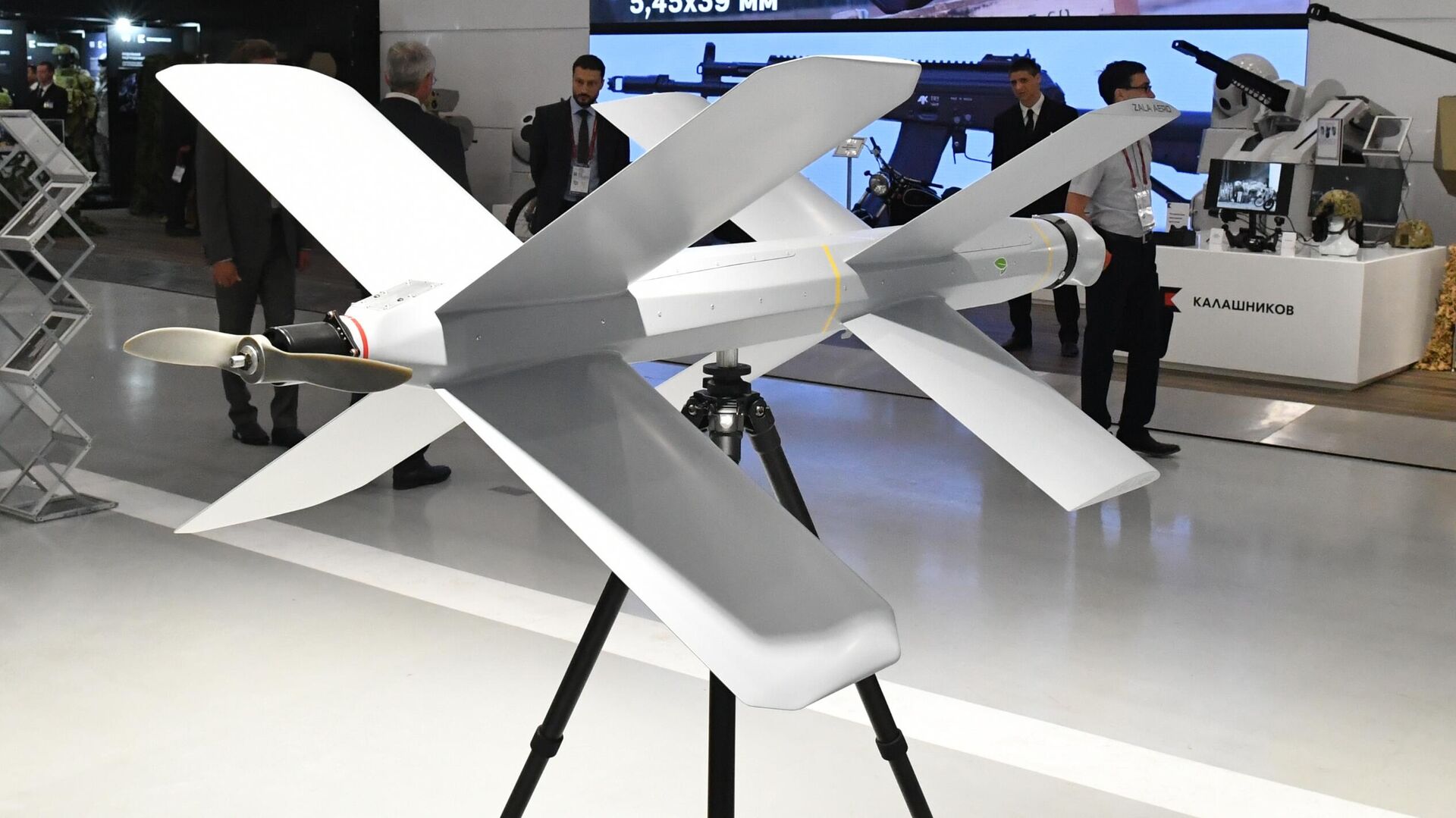https://sputnikglobe.com/20230921/how-russian-lancet-drone-surgically-struck-ukraininan-jets-cockpit-from-80-km-1113549589.html
How Russian Lancet Drone Surgically Struck Ukrainian Jet's Cockpit From 80 Km
How Russian Lancet Drone Surgically Struck Ukrainian Jet's Cockpit From 80 Km
Sputnik International
Moscow continues to successfully use various modifications of drones in the special military operation zone amid Kiev’s futile counteroffensive.
2023-09-21T06:23+0000
2023-09-21T06:23+0000
2023-09-21T07:47+0000
russia's special operation in ukraine
russia
ukraine
lancet
uav
drone
fighter jet
ukrainian counteroffensive attempt
https://cdn1.img.sputnikglobe.com/img/07e7/09/15/1113548498_0:284:2535:1709_1920x0_80_0_0_7821b269eb6f78e531c517cd851aaa31.jpg
Launched from a distance of over 80 kilometers (49 miles) in the rear of Russian defensive positions, a Lancet unmanned aerial vehicle (UAV) successfully targeted and hit a Ukrainian Armed Forces (UAF) MiG-29 fighter jet stationed at an airfield, striking it directly in the cockpit. It utilized new state-of-the-art loitering munition systems, an informed source has told Sputnik.The Lancet drones, tailored for both military and civilian applications, are developed by ZALA AERO, a subsidiary of Kalashnikov Concern situated in Izhevsk, Russia. With a flight range reaching up to 70 kilometers, they offer an endurance time of approximately one hour. These state-of-the-art drones are capable of carrying weapon payloads ranging from three to five kilograms, making them a formidable force.In the special operation zone, these UAVs are specifically designed to target a range of military assets such as UAF howitzers, air defense systems, radars, multiple launch rocket systems, as well as command and observation posts, and congregations of troops.Lancets, alongside various other types of drones, have been extensively employed during the UAF's inept counteroffensive, which Russian President Vladimir Putin called "more of a failure than a stalemate." He reports that the Ukrainians have suffered a staggering toll of casualties in their counteroffensive, with over 71,000 soldiers lost, along with 543 tanks and nearly 18,000 armored vehicles of different types since early June.
russia
ukraine
Sputnik International
feedback@sputniknews.com
+74956456601
MIA „Rossiya Segodnya“
2023
Oleg Burunov
https://cdn1.img.sputnikglobe.com/img/07e4/09/0b/1080424846_0:0:2048:2048_100x100_80_0_0_3d7b461f8a98586fa3fe739930816aea.jpg
Oleg Burunov
https://cdn1.img.sputnikglobe.com/img/07e4/09/0b/1080424846_0:0:2048:2048_100x100_80_0_0_3d7b461f8a98586fa3fe739930816aea.jpg
News
en_EN
Sputnik International
feedback@sputniknews.com
+74956456601
MIA „Rossiya Segodnya“
Sputnik International
feedback@sputniknews.com
+74956456601
MIA „Rossiya Segodnya“
Oleg Burunov
https://cdn1.img.sputnikglobe.com/img/07e4/09/0b/1080424846_0:0:2048:2048_100x100_80_0_0_3d7b461f8a98586fa3fe739930816aea.jpg
special military operation zone, lancet's kamikaze drone, use of lancet drones in special military operaion zone, lancet drone's improved characteristics
special military operation zone, lancet's kamikaze drone, use of lancet drones in special military operaion zone, lancet drone's improved characteristics
How Russian Lancet Drone Surgically Struck Ukrainian Jet's Cockpit From 80 Km
06:23 GMT 21.09.2023 (Updated: 07:47 GMT 21.09.2023) Amid Kiev's futile counteroffensive, Moscow continues to successfully deploy various drone modifications in the special military operation zone.
Launched from a distance of over 80 kilometers (49 miles) in the rear of Russian defensive positions,
a Lancet unmanned aerial vehicle (UAV) successfully targeted and hit a Ukrainian Armed Forces (UAF) MiG-29 fighter jet stationed at an airfield, striking it directly in the cockpit. It utilized new state-of-the-art loitering munition systems, an informed source has told Sputnik.
ZALA AERO has recently unveiled a range of revolutionary upgrades for Lancet's hardware and software systems. These advancements enable the flexible deployment of kamikaze drones even in situations where targets are not directly visible. Separately, new design-related solutions were also used,” the source said.
According to the source, the Lancet reconnaissance and strike complex has transformed into a powerful 'front-line long arm', serving the Russian Armed Forces in special military operation zones.
The Lancet drones, tailored for both military and civilian applications, are developed by ZALA AERO, a subsidiary of Kalashnikov Concern situated in Izhevsk, Russia. With a flight range reaching up to 70 kilometers, they offer an endurance time of approximately one hour. These state-of-the-art drones are capable of carrying weapon payloads ranging from three to five kilograms, making them a formidable force.
The Lancet drones are easily recognizable with their X-pattern wings. These drones are available in various models, one of which is the Izdeliye-51, equipped with a large X-shaped wing and a small rear X-shaped stabilizer wing. Another configuration, Izdeliye-52, has two sets of smaller X-shaped wings, and is capable of performing a near vertical dive.
In the special operation zone, these
UAVs are specifically designed to target a range of military assets such as UAF howitzers, air defense systems, radars, multiple launch rocket systems, as well as command and observation posts, and congregations of troops.
Lancets, alongside various other types of drones, have been extensively employed during
the UAF's inept counteroffensive, which Russian President Vladimir Putin called "more of a failure than a stalemate." He reports that the Ukrainians have suffered a staggering toll of casualties in their counteroffensive, with over 71,000 soldiers lost, along with 543 tanks and nearly 18,000 armored vehicles of different types since early June.



